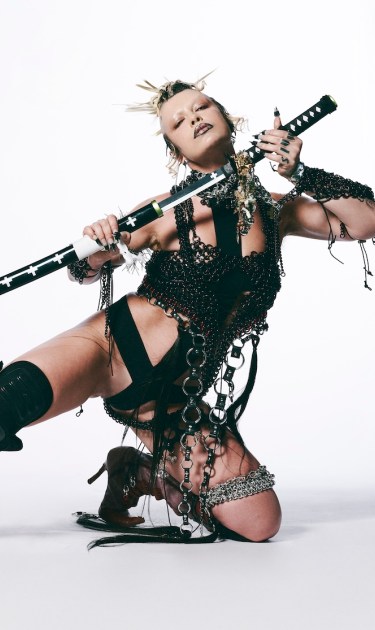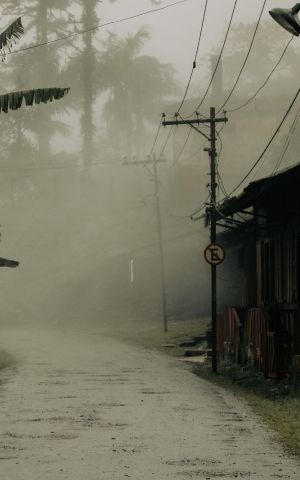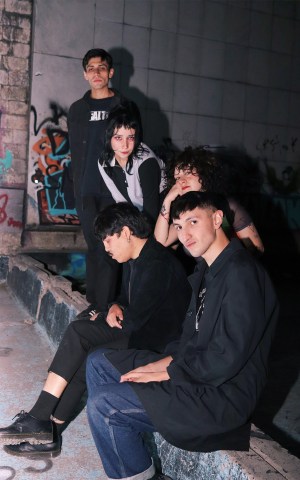Amidst sturdy buildings, skyscrapers, and tropical, three-store-high trees, São Paulo’s downtown area opens itself into another humid and warm Tuesday afternoon. In the so-called centro, Matheus Câmara walks fast to make his appointment on time. He’s wearing yellow trousers and a sling bag and, once at the bar, takes a seat and orders a beer. Then, flashing an animal-print long-sleeve shirt, comes Marian Sarine, his eyes a bit jet-lagged. He just returned to the city after touring Europe for a couple of weeks. A few minutes later, Laura Diaz joins. Her voice is potent from the moment she begins speaking about her morning; she had skipped lunch, so she orders some food. Their looks and demeanor don’t lie: they could be a band. “Teto Preto is not just a band; it’s a happening,” Diaz clarifies.
A happening, a sort of troupe with an ensemble vibe, Teto Preto is a cornerstone at the crossroads of underground electronic music and Brazil’s radical songbook — a space they’ve carved out and owned for almost 10 years. This decade anniversary marks the group’s return to the studio and the release of FALA. Blending horns and synths, intricate drumwork, and sharp punchlines, the sophomore album showcases the group’s latest lineup: Sarine on percussion, Câmara on synths, and Diaz on vocals. It’s a new team with the same motto from the beginning. “Our role is to disturb; it’s a moral thing,” reminisces Diaz, the ensemble’s founder, lead singer, and the sole remaining member of the original formation.
The project began as a resident jam in Mamba Negra, a collective that has revitalized São Paulo’s nightlife since the early 2010s with warehouse parties spotlighting BIPOC and queer artists. Teto Preto, bringing vocals and synths to the dancefloor, embodied the live energy of these parties with echoes of Brazil’s songwriting tradition — almost a club music take on rowdy MPB. The group has become a beacon of the rave scene, radiating out of one of the world’s largest cities, a leading force in today’s Latin American wave of electronic music.
“We started carrying out the Mamba identity: Brazilian electronic music that can also be experimental. So we have noise, jazz, a fusion of sounds, always with percussion and wind instruments. We blend visuals with performance, dancing — all of that plays a significant role in our work,” says Diaz, who performs under the moniker Carneosso. “[She] first emerged out of necessity. I had to challenge the figure of the muse in Brazilian music — the untouchable star or the object, a piece of meat,” she added about her onstage persona. Over the years, Carneosso has transformed from a ferocious diva with pompous, curly locks to a no less feral anti-crooner with piercing eyes and shaved head — a long-running performance, explains Diaz. “As a female artist, what we do is never enough,” she says. “We’re always serving a star system, an unreachable standard of singers with sweet vocals, a tradition deeply rooted in Brazilian music.”

This belligerent yet fair approach has fueled Diaz and Teto Preto since their inception, starting with the song “Gasolina.” Released in 2016, the single intertwines Diaz’s riotous vocals with a crescendoing, groovy techno maelstrom that boldly declares: “Gas on them.” Like wildfire, the song quickly became an underground anthem in São Paulo’s club music scene amidst the political turmoil that gripped Brazil in the late 2010s. “We’re noisy,” Diaz reflects. “Back in 2015, we embraced techno as a counterattack to downtempo, which was quite fashionable at the time in São Paulo. We were raw, aggressive. And now, with this new album, we’re exploring ‘90s influences — drum and bass, garage, revolutionary electronic music.”
As a female artist, what we do is never enough. We’re always serving a star system, an unreachable standard of singers with sweet vocals, a tradition deeply rooted in Brazilian music.
For Sarine, the wave Teto Preto rides is also a forward-thinking leap in art being made in Brazil today. Forged as a drummer for DeafKids — a unique Brazilian music act blending noise rock, psychedelia, and polyrhythmics for 15 years — he entered Teto Preto with far more than a powerful drum set and a knack for funky beats, as exemplified by the track “PSVTA*.*PRA SEMPRE VOU TE AMAR” from FALA. “Any kind of music in Brazil that sounds heavy or, let’s say, crazy, is quickly boxed in,” he says. “People who define the canon in Brazil believe they’re avant-garde, but they’re not. You need to give people what you think they need, not what you think they want.”
Câmara, Teto Preto’s wizkid on synths, approached this challenge like an adventurous puzzle of layers and construction. “We recorded tracks with, like, 150 channels — and I don’t say that in a presumptuous way — but there are many elements together that eventually sound like just eight channels,” Câmara explains. “The breakbeat cell we use, for instance, incorporates sounds from [the Brazilian traditional music genre] maracatu. It’s not just four-on-the-floor; there’s a groove in it.”

Deepening the frontline on the dancefloor and in Brazilian music, the group steps into 2025 by navigating new seas. The late 2010s economic and political crisis in Brazil, followed by the pandemic, has shrunk São Paulo’s street party scene — a movement that once reshaped the city’s underground. Moreover, the reactionary political agenda remains a risk for the next Brazilian presidential elections in 2026. At the same time, Mamba Negra still guards its place as a mainstay of São Paulo’s electronic music scene, and the world of club music has never been as interested in South America and Brazil as it is today. Not by chance, Teto Preto will tour Europe next summer, with Sonar Barcelona already on the agenda.
Amid some uncertainty, Diaz seems certain of one thing. “Sometimes people ask me what Teto Preto is, if it’s electronic or if it’s Brazilian music,” she shares, her meal finished by then. “And I tell them: It’s Brazilian electronic music.”




